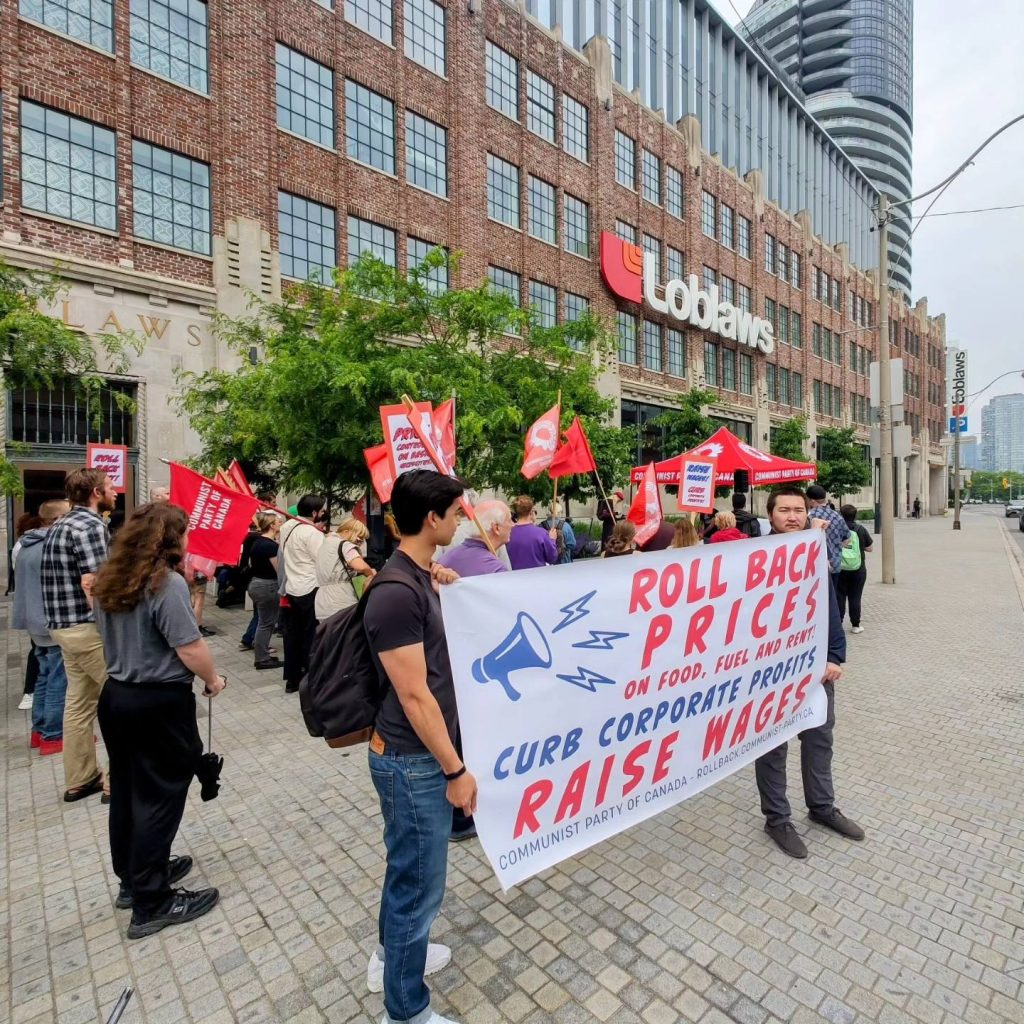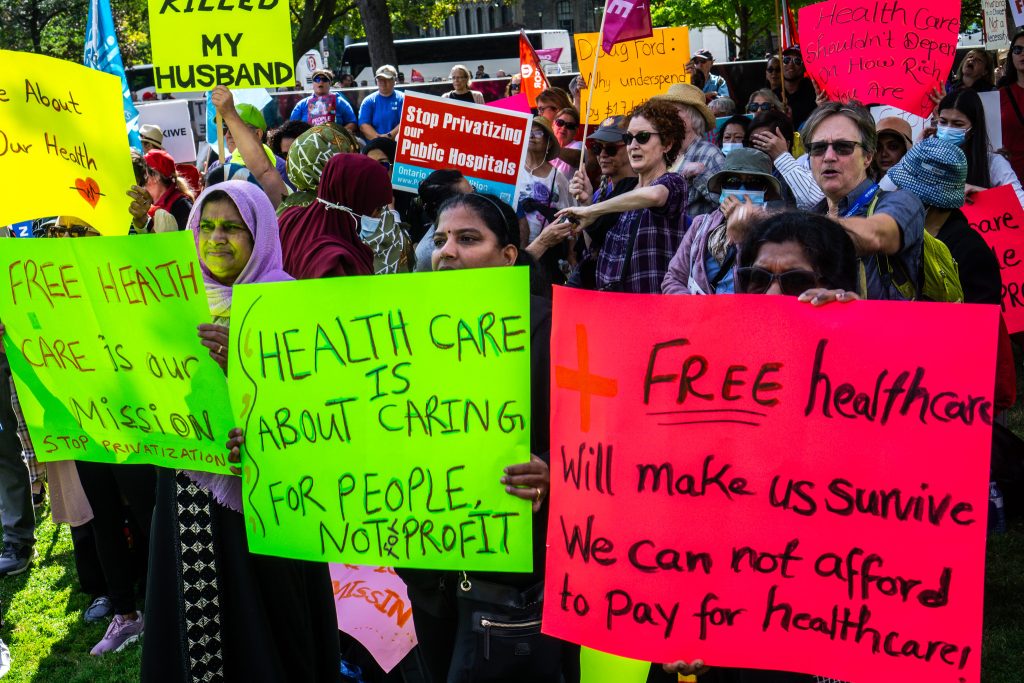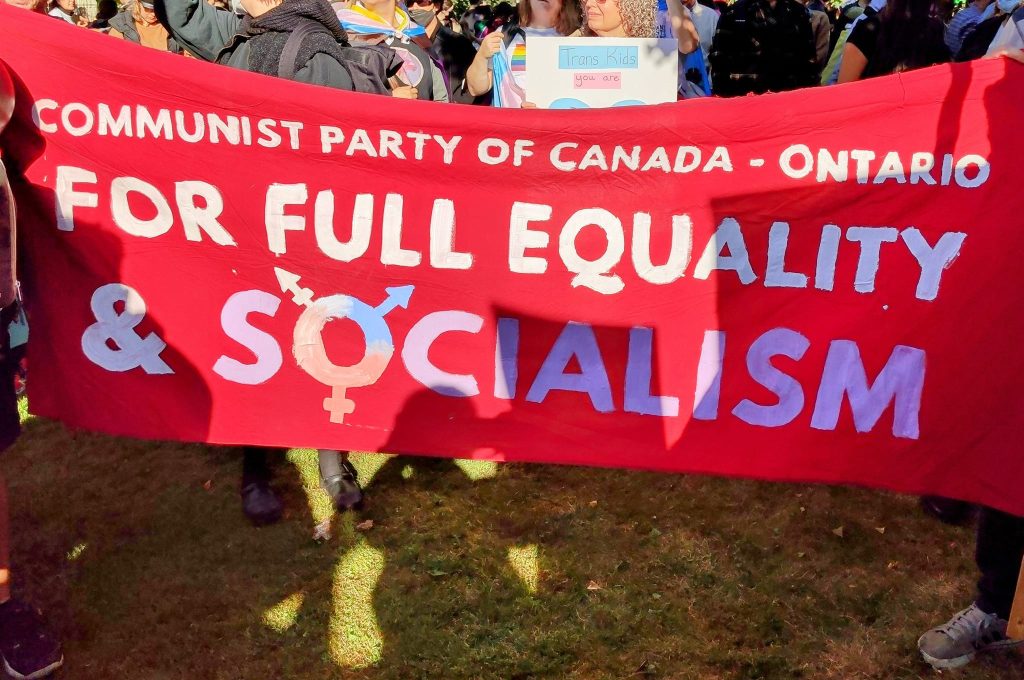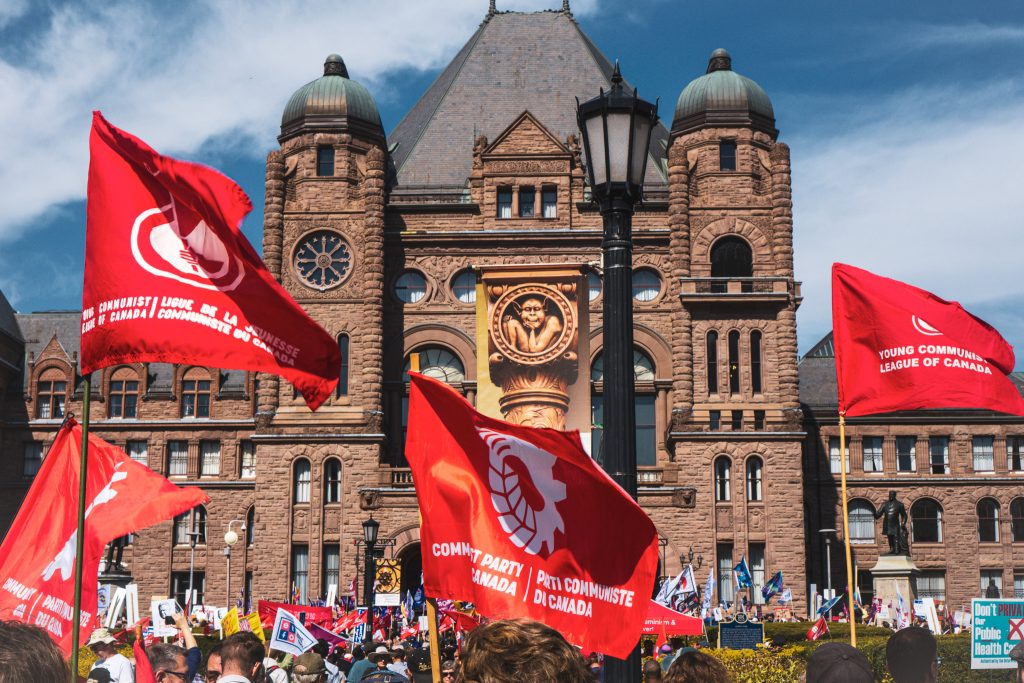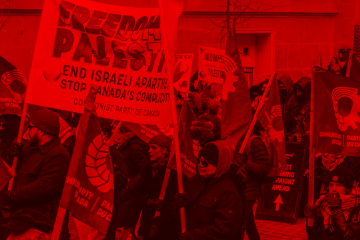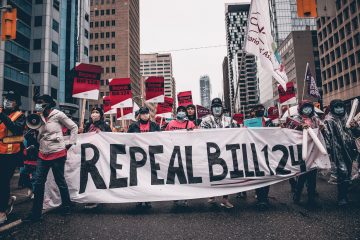The following is the political report of the Ontario Committee of the Communist Party of Canada which was discussed and amended at an Ontario Committee meeting on Sept 30th, 2023.
The political situation in Ontario
As imperialism hurtles towards world war, nuclear catastrophe and irreversible climate chaos, the living standards of working people in advanced imperialist countries continue to decline. In Canada, working people face plummeting real wages and skyrocketing costs for housing and basic necessities. Corporate profiteering and the triggering of a recession through raising interest rates is designed to create mass unemployment. The prices of necessities, including food, fuel and rent, are still soaring, even while the rate of inflation has technically declined. One job should be enough to have a decent standard of living, but it isn’t enough, and work is becoming more precarious across most sectors.
A massive transfer of wealth is currently underway, from working people to monopoly corporations and the rich. The Ontario government distinguishes itself from the rest of Canada when it comes to the scale of the theft and the willingness to attack democratic rights. Doug Ford’s Conservative government leads the way in attacking health and education through cuts and mass privatization. This especially aggressive government has already demonstrated its willingness to use unprecedented autocratic measures like Bill 28, which invoked the notwithstanding clause to break the strike by CUPE education workers and impose the corporate agenda, by force, less than a year ago.
The fightback and the future directions for the labour movement in Ontario are important to the fight across the country. It is our primary task as a Communist Party to build the revolutionary struggle for socialism. To do this effectively we must link up the daily struggles for the immediate needs of working people, unite labour and people’s movements in a People’s coalition and link the class struggle with revolutionary theory and a strategy for fundamental change and working class political power, for socialism. It is with this in mind that the Ontario Provincial Committee examines these important areas of struggle in Ontario today.
The attack on public healthcare
At the time of the last Provincial Committee meeting in late 2022, the government said publicly that they would be expanding private clinics in Ontario, reversing their lie during the 2022 election that hospital services wouldn’t be privatized. Enabling legislation was passed this spring in the form of Bill 60. The expansion of private clinics and the private delivery of surgeries will mean extra charges for care, aggressive upselling of procedures which patients do not require and a deeper drain on already insufficient government funding, as private for-profit facilities syphon profits from it.
Bill 60 makes structural changes to commodify health services. It expands the power of a Director to issue licences to private clinics, while reducing opportunity for public oversight, enabling quick privatization and offering no standards and regulations. Schedule 2 of Bill 60 creates new categories of lesser-skilled, lower-waged health workers to be created which will allow for a further deterioration of wages and working conditions which will always lead to lower quality health care and is a major attack on women who comprise 80% of the workers in healthcare.
Corporate interests are keen to capitalize on the capacity crisis in healthcare, specifically hospitals, surgeries and LTC. Several areas of healthcare – dental, pharmaceuticals, vision, and others – are already heavily privatized. As private corporations further entrench themselves in healthcare and extend their reach into areas currently covered by Medicare, it will be very hard to roll back.
The US has an all-powerful corporate health sector that has successfully held back public healthcare in that country and is responsible for countless medical bill bankruptcies and some of the worst health outcomes per dollar spent on healthcare in the world. These corporations are eyeing healthcare in Canada as an area for expansion and profiteering.
But corporate Canada has its eyes on the health sector too. Loblaw, which owns Shoppers Drug Mart, launched the PC Health App in 2020 and in 2021, purchased a chain of physiotherapy clinics. Loblaw has said that the health sector is one of its four priority areas for growth. This is one of Canada’s largest corporate monopolies, infamous for price-fixing bread and again in hot-water because of price-gouging on grocery items which continues to drive inflation.
The privatization of hospital services has resulted in a major reduction in staff and funding resources from the public sector. While privatization is being touted as a solution to the capacity crisis caused by underfunding, privatization and underfunding are part of the same policy. Bill 60 and the broader attack on public health care was well understood by the Ontario Health Coalition which rolled out a campaign throughout the spring to build towards a mass referendum where almost 400,000 Ontarians voted 99% against privatization.
Despite the unprecedented wait-times and ER closures, the Ford government is planning on continuing the cuts. There will be an 8.4% increase in bed capacity over the next decade while their own projections show the demand for a 15% increase based on population growth alone. The 15% increase doesn’t address the rapidly ageing population of Ontario. The crisis for beds in hospitals is on track to get much worse.
The government is planning 3.9% per year health funding increases from 2022-2028. Even before the massive wave of inflation, the needs of the healthcare system due to cost pressures were identified to be at least 5% per year. Furthermore, the government has been underspending its already insufficient healthcare budget, with an estimated $1.7 billion remaining unspent in the public system last year. At the same time, the Tories are overspending their budget on private clinics.
While Ford was, in-part, elected on the promise to “end hallway medicine” in 2018, his government has proceeded to deepen the underfunding and privatization, striking at the core of Ontario’s public health care infrastructure. As the Ontario Health Coalition has stated recently, “we need to take action as though our public health care is in grave danger. Because it is.”
Another aspect of the underfunding of social programs related to health is the crisis in the Workplace Safety and Insurance Board (WSIB). In 2022, the government ordered WSIB to pay out rebates of up to $1.5 billion and cut premium rates paid by business by $168 million, bringing the total reduction in premiums since 2018 to $8.5 billion. While businesses are refunded a massive WSIB surplus, injured workers are being underpaid or not paid at all. While workplace injuries and even deaths are severely underreported, even those that are reported to WSIB are met with a “look to deny mentality”, through various problems, including a system that often overrides a workers’ own doctor’s recommendations. The recent decision to relocate the WSIB office from Toronto to London to allow “$70 million in annual savings” shows once again that the government is trying to squeeze as much money out of the system and back into business pockets as opposed to expanding payments to workers.
The Greenbelt theft
Soon after the 2022 election, Municipal Affairs and Housing Minister Steve Clark announced the “tough decision” to open up thousands of acres of the Greenbelt for development. This was after Doug Ford was exposed in 2018 as having promised developers access to the Greenbelt. Ford used the housing crisis and desperate need to build houses as a pretext to attack the environment and important agricultural land.
In August, the Auditor General reported that of the 7,400 acres of land removed from the Greenbelt, 92 percent could be tied to three developers with direct access to the housing ministry. The owners of the 15 land sites chosen through this process could see more than an $8.3 billion increase to the values of their properties. The report also found that Clark’s Chief of Staff provided all but one of the sites that were ultimately removed from the Greenbelt, “at least nine of which came from requests made by a few select developers and their representatives, who contacted him personally.”
While the corporate media and Ontario’s Integrity Commissioner mostly focused on Steve Clark and his Chief of Staff’s ties to profiteering developers, Doug Ford and his party have longstanding ties to these particular developers and the industry more generally. Ford invited developers, including those that benefited from the Greenbelt deregulation, to a pre-wedding fundraiser for his daughter in 2022. The Tories’ 2018 election campaign – the first under Ford’s leadership – was well funded by developers, and a further half a million dollars in developers’ money was spent by the “third party” entity Ontario Proud. Clearly, the Conservatives are the same political entity as Ontario’s largest developers.
The Communist Party supported the demands of environmentalists, farmers and unions as well as 83 percent of Ontarians who want the opening of the Greenbelt immediately reversed. In late September, the government announced that they would reverse the plans to develop the Greenbelt, only as the scandal came closer to implicating the Premier directly. We need ensure that all of the lands removed from the Greenbelt are returned, not a portion and not a swap with other land.
This scandal is another case of corporate power directly dictating public policy. The Communist Party has called for a full public inquiry into the mechanisms through which private interests have captured development and land policy. We need to look well-beyond Steve Clark and even Doug Ford and the Conservatives to see the roots of this scandal which is ultimately corporate power and the commodification of housing.
Privatization of housing has shown itself to be a dreadful failure. Currently, 700,000 households in Ontario are in core housing need – meaning they are paying more than 30 percent of their income on housing that is inadequate, without access to acceptable alternative housing.
Ontario needs is a massive public housing program, rooted in the idea that housing is a human right and should be treated as a public utility. While even the most willing political servants of corporate Canada now admit there is a severe housing crisis, the policy options on the table remain narrow and do not tackle the privatization of housing. The provincial and federal governments must re-assume a leading role in building and providing housing on a rent-geared-to-income basis. Governments must take direct action and develop an emergency plan to build 200,000 new, publicly owned, social housing units, and upgrade existing units, to address the massive core housing need in all areas of Ontario. As this is done, and if such a program continues as an ongoing and expanding public service, average prices will come down, providing relief and stability to renters and homeowners.
We must fight the current reframing of the debate by both the federal Liberal and the provincial Conservative parties that seek to blame immigration, including international students, for the housing crisis. Housing policy remains a class issue – the roots of the crisis are caused by those that profit from it.
Attacks on local democracy and autonomy
The Ford government has stepped up its attack on local democracy since its reelection in 2022 for the benefit of private corporate developers.
In a cynical use of the housing crisis to increase corporate profit and restructure governance in Ontario, the Conservatives have now bestowed “super mayor” powers on 49 cities in Ontario. This allows mayors to pass bylaws which reflect provincial priorities, with the support of only one-third of their respective councils. “Provincial priorities” are not defined in the legislation and are consequently subject to the whims of the provincial government. The Ford Conservatives demonstrated priorities include privatization of public services, sacrificing environmental protections for developers’ profits, public investment in private enterprise and transferring wealth from working people to corporations and the very wealthy. Local democracy is clearly not a provincial priority, as the proposed legislation will mean that councils require a more than two-thirds majority to block “Ford endorsed” bylaws.
In Toronto, there is hope for some pushback against the Ford government with the election of Olivia Chow in the mayor’s office and the defeat of the Conservative Party for the first time in over a decade. However there are many obstacles to gains for the working class with a right dominated council and the need for a broad coalition to push Olivia Chow to enact some of her progressive policy positions and to expand on them. Another key obstacle is the Ford government’s willingness to override local democracy and autonomy, which will mean the fight for democracy and autonomy and the need to build civic reform movements may become even more important.
A recent development at the Toronto level is the request by council to the Province to grant the city the power to implement a Municipal Sales Tax (MST) on purchases in the city of Toronto. While it is certainly beneficial that Toronto is exploring revenue tools and recognizing that property taxes are insufficient and regressive, a sales tax is also an inherently regressive form of taxation. Sales taxes put a disproportionate burden on working people because they are not based on people’s ability to pay, but are instead based on how much of their income they spend on consumption. Working people tend to spend most of their incomes on basic necessities while the more you earn the more likely you are to spend a smaller portion of your income on taxable goods and services. The Toronto and York District Labour Council has spoken against the MST proposal recognizing it’s regressive nature and also pointing out that the tax will be deeply unpopular and impossible to mobilize support for in order to get the Province to move on changing the city funding model. Instead, Toronto and all cities should unite to demand a new financial deal through statutory grants at levels sufficient to meet their needs, and in the absence of that, wealth-taxing powers which can target corporations and the very wealthy.
Cities are still suffering from the downloading of services and programs downloaded from the province in the 1990s. The costs of services still need to be returned to the province to be adequately funded and to ensure equal access across the province. While the cost of services needs to be uploaded, delivery, administration and control must remain municipal. It is absolutely true that cities need a new financial and political deal in order to expand local democracy and autonomy and provide decent living standards for their inhabitants, but a new sales tax is a danger to working people in Toronto and sets a dangerous precedent for other cities.
Stephen Lecce, Ford’s longtime Education Minister, has launched another attack on local democracy through Bill 98. This bill takes aim at school boards in Ontario. The “back to basics” political messaging of the legislation is a dog whistle to the far right which has been mobilizing against trans-rights-initiatives by school boards. However, the danger of the bill is more than its nod towards transphobia and homophobia. It also gives the province new powers including the ability to dissolve boards and appoint a provincial supervisor in place of trustees if boards don’t make “achievement targets”. School boards must also now disclose exactly what teachers and staff are learning during their professional development days, which is likely another dog whistle against board provided equity training.
The bill also streamlines the process for school boards to sell off properties, which many school boards are pressured to do due to chronic underfunding. With several provinces eliminating the powers of school boards altogether, school boards and all defenders of public education should take a stand now against this incursion.
What is needed is a coalition of unions, parents, education workers and students, which can launch an escalating campaign to press for adequate needs-based funding, expanded local democracy, and curricula and programs which meet student needs. The Campaign for Public Education has filled this role at different times, and should be strengthened.
Education
The fight for public education is heating up across the province this fall, as collective bargaining continues to drag on and most unions are moving towards strike votes. Teachers’ salaries have stagnated for decades and with recent cost of living hikes affecting all workers, salary remains a key issue at the table. The government has also moved to attack sick leave and benefits and the unions are continuing to fight for smaller class sizes, adequate supports for special education, and against violence in schools and an expansion of online learning, which the Ford government has been pushing even before the pandemic as a way to privatize education.
Education Minister Stephen Lecce has continued to show contempt for teachers, school boards and students. In addition to Bill 98’s attack on school boards, the Minister signalled in August that he approves of New Brunswick and Saskatchewan’s anti-trans policies. These policies make it mandatory to out trans children to their parents if they request a pronoun or name change at school, regardless of family dynamics and potential violence. The all-out attack on the rights of 2SLGBTiQ+ children is also an attack on public education that could justify furthering the cause of private religious schools. It is a dangerous movement that is bringing together various religious fundamentalist and ultra-right forces which will further other reactionary causes, including attacks on women and racialized communities. The Ontario government’s motivation, while no stranger to regularly furthering social reaction for its own sake, looks a lot like a move to distract from the central problems in education that all parents are concerned with: the underfunding of education and the associated ballooning of class sizes and erosion of the quality of education. Unfortunately this distraction, an attempt to divide parents and teachers, will result in increased violence against trans children.
There is a similar sustained attack taking place against anti-racism education in Ontario by right-wing forces. They refer to anti-racism education (often referred to as Diversity, Equity and Inclusion programs) as “race-baiting” and even accuse the programs of spreading racism. Recently in Toronto, the tragic death by suicide in July of a former school principal is being opportunistically exploited by people who want to cut anti-racism work from the public school system. The former principal’s lawyer claims that his death was the result of abusive treatment he received at mandatory anti-racism workshop for Toronto District School Board educators, held in 2021. Specifically, the lawyer says that the workshop facilitator, a Black woman, called the man a “white supremacist” after he questioned one of her statements about the level of racism in Canada.
Immediately, right-wing politicians and pundits launched a wave of condemnation against the workshop, the facilitator and the entire notion of anti-racism education. The Conservative provincial government postured that it would be reviewing the program and funding. Except, the reality is that the workshop facilitator never called the man a white supremacist and the story was made up by the lawyer. Our schools need anti-racism programs and we need to defend and expand those programs, against all the lies that the right-wing opportunistically throws at them.
The provincial government continues to deepen the chronic underfunding of post-secondary education (PSE). While enrollment has stagnated and domestic tuition fees have been largely frozen since 2019, public funding has continued its decades’ long decline with universities and colleges facing consequent funding shortfalls. In fact, government funding now provides just 21.4 percent of revenues in Ontario as of 2021, meaning PSE funding has been largely privatized by relying on tuition fees. School administrations have then continued their moves towards neoliberal restructuring while the government has continued to push for greater connections to industry and an emphasis on “innovation”, which essentially means more privatization and corporate control over curriculum.
The neoliberal funding model, pursued by successive governments in Ontario, has a particularly hard impact on smaller universities and colleges and those in Northern Ontario. While the small number of “elite” institutions are able to attract students willing to pay high fees, many more are facing serious budget restrictions and will face pressure to impose serious anti-worker and anti-student cuts, as Laurentian did. This will further skew PSE away from community and social priorities and toward those of large corporations and private funders. The announcement in 2022 of a private for-profit university in Niagara Falls is a massive attack on public delivery of education. The University of Niagara Falls Canada (UNF) is owned by Global University Systems, a Dutch multinational that also owns schools in the UK, Israel and Europe. While private universities in Ontario only enroll 1,500 students, this major planned expansion promises more fully privatized schools.
There could easily be a more substantial attack on post-secondary education coming in the near future. In the spring, the Ford government announced the creation of a “blue-ribbon panel” to look at “how to improve the financial sustainability of the postsecondary sector”. The panel is dominated by corporate interests and chaired by Dr Alan Harrison, who was a special advisor to the government on the Laurentian University insolvency where creditor protection was used for the first time in the sector to gut and restructure that institution, including the loss of 340 jobs. The panel includes absolutely no current students, staff or faculty and has been denounced by most of the staff and faculty union affiliates in the sector as well as the Ontario Federation of Labour (OFL) and the Canadian Federation of Students – Ontario (CFS-O).
Another major change in the sector that has developed considerably is the expansion of international student enrollment. Since 2016, the number of international study permits issued for Ontario has tripled to over 100,000. Seven of Ontario’s 24 public colleges now have more international students than domestic students enrolled, and much of the growth is focused at so-called “satellite campuses” or “partner schools” in the GTA.
International student tuition fees were differentiated in the 1970s and have been the subject to significantly less regulation by governments, which has caused them to balloon to three to ten times as much as domestic students pay for the same education. With the decline of public funding, postsecondary institutions have turned to international students as cash cows, to fund and expand schools. However, there are recent decisions which have caused this exploitation to grow more quickly. At the beginning of Doug Ford’s first government, policy was changed to allow public colleges to partner with private entities and set up “satellite campuses” in the GTA. These institutions, many of which are located in strip malls and at drastically inferior campuses to the main public campuses, have increased dramatically in recent years, despite a recent cap of 7,500 international students per college. These “partner schools” teach the same curriculum and can give out Ontario college degrees.
What attracts many international students is the pathway to permanent residency. After graduation, international students are able to work for three years, and if they can find permanent employment are likely to be able to get permanent residency – at least in theory.
What has developed is a system where international students are often triply exploited. Once by education brokers or consultants, either in their home countries or Canada, who “help” them through the process of enrollment, then by the academic institutions who extract massive tuition fees while sometimes providing substandard learning experiences than domestic students, and then by employers who use international students as cheap and precarious labour. Many, if not most, of these international students will not attain their goal of permanent residency, especially with the coming recession and rising unemployment.
Now international students are being blamed for the housing crisis, recently by Sean Fraser, Canada’s Housing Minister. While it is certainly true that immigration remains one of many factors in increasing the demand for housing, international students and immigrants are far from the root of the problem. International students are also victims and convenient scapegoats for the housing crisis.
International students should be welcome in Ontario since they do enrich campus life and the learning for all students and contribute socially, culturally and economically to the province. However, this exploitative and rapidly expanding international student system must be ended. The Communist Party demands an end to the privatization through the accreditation of private satellite campuses, and we reiterate the longstanding demand of the student movement to end differential tuition fees for international students.
Expanding the privatization of energy
While the effects of climate change are already throwing ecosytems into chaos, burning towns and affecting peoples’ health across the country, the necessity for public ownership and democratic control over energy resources and industries is essential to shifting to sustainable energy, by developing publicly owned and operated wind, solar and hydroelectic energy production. The government has moved in the opposite direction, cancelling renewable projects and expanding privatization.
One of the first Ford government’s acts was removing the requirement that carbon emissions targets be set in law and the cancellation of over 750 renewable energy projects throughout Ontario, including decommissioning nearly completed projects. The current state of wind power in the province does not decrease overall emissions. The system operates far below capacity but producers get paid for what it could theoretically produce. Even when wind is producing some energy, it mainly just decreases reliance on already emissions-free hydroelectic production at a loss of almost $1 billion a year. The current system of wind power is largely rooted in the private sector and because it’s managed for profit it is inefficient.
Meanwhile the Ford government has moved to future nuclear expansion from Ontario Power Generation (OPG) to the privatized Bruce Power. The OPG had a licence for site preparation of a nuclear newbuild of up to four reactors at Darlington. The licence ended in 2022, without the government moving on it for ten years. Almost immediately after the expiry, the government decided to direct Bruce Power to begin planning for a nuclear newbuild on the Bruce generating station site. The OPG then applied for a licence for experimental Small Modular Reactors (SMRs) that have never been built in a commercial capacity before. The development of SMRs in Ontario are likely to go significantly over budget and be used to politicize the “inefficiency” of public power, providing greater support for the expansion of Bruce Power and privatization in general.
Instead of building Ontario’s necessary expansion of power generation on schemes to funnel public money to private interests, the Province must develop truly sustainable energy by building publicly owned and operated wind, solar and hydroelectic energy production and increasing conservation.
Furthermore, expanded public power generation is key for an industrial strategy for Ontario. With a recession looming, the need to create jobs by restoring and expanding value-added manufacturing and secondary industry will only become more important. While arms manufacturing is expanding in Ontario as part of the growing global trend towards militarism and war, the moment calls for socially necessary manufacturing. Our long standing demands to restart Ontario’s domestic steel industry under public control and build a publicly-owned and democratically controlled and operated emissions friendly, light vehicle industry are as important as ever. Ontario needs a comprehensive, planned, industrial policy with public ownership at its centre, and a key foundation for that is public power.
Conservative attack on women and gender equality
The Ford government’s policies have a particularly big impact on working women (which includes trans women). Attacks on public sector workers in general have disproportionately affected women, who comprise a majority of workers in the sector. However, this impact becomes especially lopsided in the Tories’ two favoured targets: public education (where 75 percent of teachers and 70 percent of education workers identify as women) and healthcare (in which an estimated 80 percent of workers are women).
Forcibly reducing the wages and compensation of these overwhelmingly women workers, as Ford did through Bill 124, immediately weakens their economic and social security. But in the context of a systemic gender pay gap – equivalent to about 87 percent of hourly wages and 73 percent of annual earnings – these reductions have huge compound effects which severely compromise women workers’ incomes into retirement. Across Canada, 21 percent of elderly women live in poverty.
In addition to strong action to achieve and maintain pay equity, working women generally need access to affordable childcare. Yet, despite much public fanfare when it was announced in April 2021, two-and-a-half years later the federal government’s “$10-per-day” childcare plan is quickly becoming a sad joke. Much, but not all, of the blame rests with Doug Ford and other right-wing premiers who have delayed negotiating provincial childcare deals with Ottawa and insisted on heavy involvement of for-profit operators.
The Conservatives are also undermining women’s hard-earned abortion rights in Ontario. While Ford has been careful to state publicly that his government is “not changing anything” in terms of abortion access, he allows Tory caucus member Sam Oosterhoff to speak at anti-choice rallies and pledge to “make abortion unthinkable.” Ford’s healthcare cuts directly limit the availability of abortion services throughout the province. Currently, Ontario has only 38 abortion providers throughout the province, with only four of those in rural areas. This includes 22 hospitals, several of which reduced abortion services in response to funding cuts. Furthermore, the Ford government has ignored applications from abortion providers to approve safe access zones at their facilities, opening up women and workers to intimidation, harassment and violence from anti-choice protesters.
The Tories’ casual disregard for women was reflected in their refusal to recognize Intimate Partner Violence as an epidemic, as called for by the inquest into the 2015 murders of three women by their partners.
In addition to attacking women’s rights and equality, the Conservatives have advanced the anti-LGBTQ+ narrative – and especially anti-trans hate – in Ontario. In early September, Ford tried to deflect public opinion from the Greenbelt scandal by criticizing school boards and teachers who keep information confidential about students’ sexuality and gender identity, including from parents. This anti-trans dog whistle echoes similar attacks from Tory premiers in New Brunswick and Saskatchewan. Unfortunately, a number of people on the political left still lack confidence or clarity around trans issues – namely that trans women are women and trans men are men – and are consequently less equipped to confront this aspect of the right-wing attack on gender equality and justice.
The fightback in Ontario
Since the Provincial Committee’s last meeting, workers’ wages have continued to be eroded by skyrocketing price hikes on basic necessities, and now many are also feeling the pinch of higher interest rates on mortgages and debt. While inflation rates have declined slightly, grocery costs and rents, continue to skyrocket with the cost of food in Canada increasing at around 8% for most months in 2023 over the same month in the previous year and the average asking price for rent across Canada in September was up by more than 11% compared with a year ago. Consequently, the strike wave we identified in 2022 has only grown and we have seen a definite renewed militancy in labour. There have been several notable “no” votes on tentative agreements in the last few months, which forced some union leadership to catch up with their members’ demands. These include the workers at Windsor Salt who were out on strike for six months fighting outsourcing, workers at National Steel Car in Hamilton fighting for better wages and health and safety and, most recently, Metro workers in the GTA. Metro workers voted down a “historic” tentative agreement because “better than usual” was still too far behind. Increasingly, workers are demanding they catch up and reverse the recent massive erosion of living standards. Our Party was involved in building solidarity with these important strikes in the past few months.
These strikes have, on the whole, shown that it is possible to fight and win strikes, even against large corporate monopolies in the case of Metro and Windsor Salt. Along with important high profile strikes like the PSAC strike in the spring and the ILWU strike at the port in Vancouver, they have put labour back in the front page news across the country. They’ve proven the labour movement has a fighting future.
But they’ve also highlighted weaknesses that need to be overcome. One such weakness is the continued isolation of Unifor, still outside of the CLC, which has blocked some efforts at solidarity. The unity of the labour movement is more crucial than ever during this upsurge. These strikes have also shown that labour leaderships need to learn or relearn class struggle trade unionism. If right-wing labour leaders are unable to learn the lessons needed for the moment, they need to be replaced and we have seen some positive signs of this with Unifor and OPSEU, and Teamsters and UAW in the United States.
However, changes at the top need to be pushed and sustained by the labour grassroots. Without a strong network of active left caucuses at the local level, the labour leadership will be drawn to right-wing social democratic positions including electoralism and opportunism.
Looking at the public sector in Ontario we can see several struggles brewing. This is a sector that is still reeling from Bill 124. Although the bill was struck down, the full effects of the bill, cutting wages for one million workers in the broader public sector, have not been reversed for many workers. As schools start the school year, teachers are organizing strike votes as bargaining has stagnated after a year.
The exception is OSSTF (public high school teachers and education workers) who have proposed to enter into binding arbitration with the province. Hopefully members will vote against this tactic, as it feeds into the anti-labour agenda of the Provincial Tories. The right to strike is one of the most hard-fought rights won by unions over the past hundred years and willingly giving up the right sends the wrong message to other unions and the province.
Binding arbitration also eliminates membership mobilization as it takes away the ability of locals to take a strike vote that would show the strength of their local. It also takes away, ultimately, members’ right to vote on a final contract.
Other teachers’ unions have said they will not enter into binding arbitration. Aside from wage and benefit increase, other education unions have important issues to fight for, including violence in schools and gender equity protections. OSSTF’s decision undermines a potential united front of education unions.
We can count on more strikes across the public sector as the Ford government continues to force below-inflation increases. The Tories’ increasing viciousness is driven by an economic backdrop in which corporations are pushing for higher profits and expanded power at the expense of wages, pensions and benefits, labour rights and public services. This is what gave rise to Bill 28 and Ford’s strikebreaking strategy against CUPE education workers. Although this was defeated through the courage and militancy of education workers and seldom seen unity in the labour movement, we can expect similar anti-democratic and union busting manoeuvres from the government and its corporate backers.
This is not a fight which will not wait three more years until the next election – it’s here now and will continue to sharpen. Working people cannot afford a “play-it-safe” strategy in which labour outsources its political demands and action to the NDP. Elections do matter, but a narrow reliance on electoralism, which pushes aside the necessary fight in the streets, has failed before and will continue to be a losing strategy for the working class.
Labour needs to lead with its own demands, like those being advanced by the OFL’s “Enough is Enough” campaign – raise wages; stop privatization; ensure affordable food, fuel and rent; and make the banks and corporations pay. Campaigning on these policies raises the political bar, forcing all parties to respond to a people’s agenda for Ontario. It builds the basis for a stronger election campaign in three years, mobilizing a wave of mass pressure which can defeat the Conservatives and their corporate agenda. A government elected in the wake of such a campaign – including an NDP government – can be compelled to introduce more fundamental change than just pushing a more “friendly” version of the same corporate policies.
Elements of what’s needed to defeat Ford are already visible. The June 3 province-wide Day of Action and the Ontario Health Coalition’s recent workplace and community referendum against healthcare privatization have brought together thousands of labour and community activists. The “Enough is Enough” campaign demands, and the increased unity and militancy seen in strike solidarity are hopeful signs, but they need to expand. The main weaknesses of the campaign so far were the uneven adoption of it by affiliates, a lack of resources and leadership at the OFL, and a lack of structure to bring together labour with community organizations.
We need to grow this movement quickly and with deeper roots, by building labour-community solidarity in local grassroots fightback committees. This kind of organization is key to sustaining and building large mobilizations, as we have seen many times, including during the Ontario Days of Action in the 1990s.
Unions need to commit resources for organizing, to help build and mobilize local committees. Among other things, this means providing money for booking off and hiring organizers. Part of the problem is that labour conventions have moved away from passing motions that include the commitment of resources with them. Recently, affiliates are more likely to contribute money for advertising campaigns, but we need to focus on building mobilizing capacity in the labour movement. We cannot limit ourselves with strategies that focus on lobbying, buying billboard ads and pouring resources into “swing ridings” during elections.
Mass action, including political strikes, works. The current working-class struggles in France and Britain demonstrate that sustained, widespread mobilization is possible and that mass political strikes have the power to shake governments to their knees and even bring them down.
This kind of movement needs to be built – it cannot be brought into existence by sloganistic motions calling for an immediate unlimited general strike. We need an escalating campaign that increases the size and scope of our mobilizations, and which includes the political strike weapon. The conditions of the class struggle can develop very quickly, but without organization and preparation now, we will not be able to effectively launch a general strike.
The student movement across Ontario, and most of Canada, has hit a low ebb in recent years. After decades of defeats, skyrocketing tuition fees, attacks from right-wing students and school administrations, the Canadian Federation of Students, English Canada’s only independent student union federation, has suffered splits and is in decline. This reflects a demobilization at the local campus and union level as well. However, there is some hope that things will turn around now that students are back on campus and not only doing online learning and the fightback is clearly gaining steam off campus. There has been a student day of action for free education called for this fall, the first day of action called in seven years. This will be important for the student movement to unite in action and also politically important as the Ford government is looking to revamp the sector with the recommendations of the business oriented “blue ribbon panel” it has convened. The Communist Party pledges support for the day of action and will help to build the fight for free education.
An increasingly active section of the student movement has been international students. As the number of international students have expanded in recent years the problems they face have become worse. This has included schools reversing their acceptance of enrollment and problems with study permits because of predatory education agents. Students from India in particular have been fighting back, organized through the Naujawan Support Network (NSN), which formed out of solidarity actions with the farmers’ movement in India and started organizing against wage theft over the last two years. In late May international students and their supporters occupied the parking lot outside of the Canadian Border Services Agency in Mississauga to demand the deportations of 15 international students be stopped. These students were part of a larger group of hundreds of students who were being threatened with deportation for the supposed breach of immigration laws by signing fraudulent college admission letters. However, these letters were put together by “education agents” in India who received fees to help navigate Canadian immigration. The students received broad support and our Party and the YCL participated in solidarity efforts. After 18 days of the “24-hour protest” the government postponed the pending deportations until investigations could be completed. This was an impressive and important victory. Now, there is an ongoing battle with Northern College, which has a satellite campus in Scarborough, who has reversed the decision to accept hundreds of international students, many of whom have already moved to Canada. Organizing efforts of international students and their importance to the broader student movement will only grow more important as the exploitation of international students increases.
The fightback against anti-trans inclusion policies in public education has been heating up this fall with reactionary “One Million Families” mobilizations. Local progressive coalitions formed in solidarity with the 2S/LGBTiQ+ communities; longstanding debates about strategies and tactics have re-emerged. The so-called “parent’s rights” movement needs to be exposed, disrupted and confronted. We need to make sure that everyone knows that religious fundamentalist and ultra-right forces are the main organizers here and clarify any confusion on the left by the attempt to couch anti-trans attacks in seemingly progressive women’s movement language, such as “defending cis-women’s only spaces.” In terms of tactics, adventurist actions of a small number of people, however well meaning, often create a negative outcome when they discourage broader coalitions and scare off others that are not willing or able to be a part of physical confrontation. Mass counter-protests are far more effective at preventing marches and isolating reactionary movements than small and narrow ones. Effective demonstrations are usually organized by mass organizations with as much unity as possible in strategy and tactics. This is why bringing the labour movement into the centre of the fight against this and all reactionary movements needs to be key to our strategy.
Another major fight brewing in Northern Ontario is the fight of First Nations for sovereignty and to protect their land and waters in the face of new mining developments being pushed by the Province. On September 27th, five First Nations travelled to Toronto to lead a march calling on the government to end unwanted mining activity on their territory and end Ontario’s “free entry” mining system which facilitates the theft of Indigenous lands by mining companies. Last May, Northern First Nations leaders were in Toronto again demanding “No Ring of Fire without consent”. Two leaders were expelled from the Queen’s Park gallery after Ford refused to meet with them. These actions are being led by the First Nations Land Defence Alliance, which includes the Kitchenuhmaykoosib Inninuwug (KI), Wapekeka, Neskantaga, Muskrat Dam and Asubpeeschoseewagong Anishinabek (Grassy Narrows) First Nations and whose combined homelands cover 60,000 square kilometres in Northern Ontario. Ford has repeatedly said he is determined to develop the Ring of Fire and his government is very close to mining interests, so these encroachments on Indigenous lands seem like they will develop into confrontation. The Communist Party stands in solidarity with Indigenous nations in their fight against ongoing genocide, land theft and for sovereignty.
A key front against the Ford government which has gained a lot of support over the summer is the fight to protect the Greenbelt. In August, the Auditor General’s damning report solidified and broadened opposition that already existed. Since that time, the scandal continues to deepen and the demand for all of the Greenbelt planned development grew louder until Ford announced the reversal in late September. It is this issue, along with the privatization of healthcare that seems to be hurting Ford’s popularity outside of the major cities in Southern Ontario, with organizing taking place in small centres and rural areas.
The Communist Party has spoken out against the removal of land from the Greenbelt, but we have also tried to intervene to connect the struggle for affordable housing as both issues are linked to the government’s total subservience to the development industry. There continues to be capacity for combining environmental struggles with those of other movements, such as housing and tenants, as well as peace and anti-militarism. We need to prepare more materials which bring a class analysis to the environmental and climate justice movement, and consider making assignments where possible.
The fightback against the Ford government’s privatization continues to advance as well. Thousands of other activists mobilized almost 400,000 votes during the Ontario Health Coalition referendum in May. In several cities the Communist Party helped to organize polling stations and get out the vote. September 25th, the opening of the legislature saw a massive protest by the OHC with mobilization from labour and buses from around the province. The fightback continues to advance, but the legislation has passed and the privatization of hospital services is already underway. It is imperative to build the movement to protect public healthcare now. Investors must be forced to think twice before funding private clinics. It is now more important than ever to keep track of opposition parties’ promises in the area of healthcare. The fight for public health care is also an important part of the broader fight against the Ford government and their corporate policies, which cannot wait for the next election.

